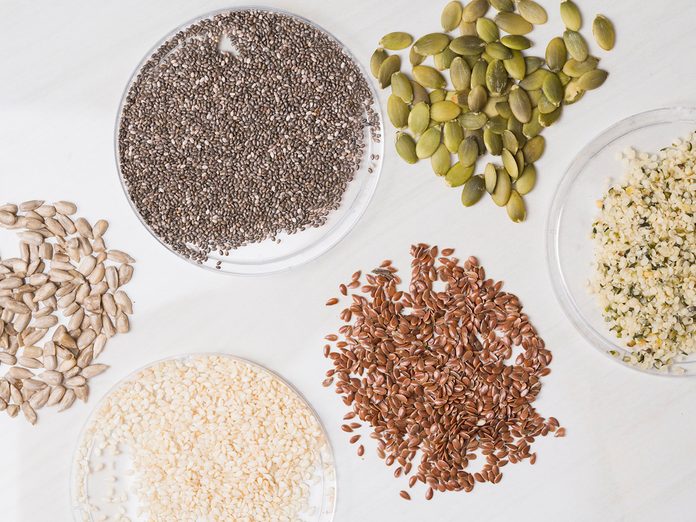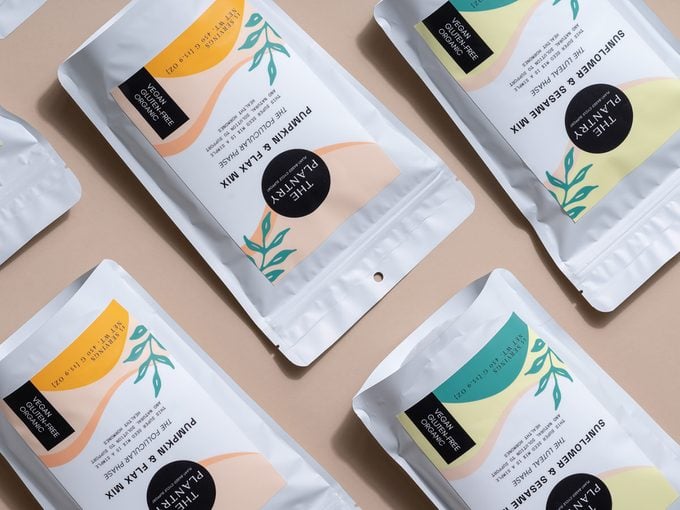Should You Try Seed Cycling to Improve Your Menstrual Cycle?

Here’s what a registered dietitian and a holistic nutritionist have to say about whether it can alleviate your PMS symptoms and regulate your period.
For a couple of years, the term “seed cycling” has been gaining popularity, increasingly dropped by wellness influencers as they share recipes for seed-focused yogurt bowls, salads and energy bites. On Instagram, #seedcycling has been used nearly 20,000 times, and on Tiktok, stories tagged with the same hashtag have gained almost one million views.
So, what is it exactly? Seed cycling is inspired by Chinese medicine and thought to help manage hormones during menstrual cycles. Specifically, it involves eating one tablespoon of flaxseed and one tablespoon of pumpkin seeds every day for the first two weeks of your cycle (known as the follicular phase), which starts the day you get your period, and one tablespoon each of sunflower seeds and sesame seeds every day for the last two weeks of your cycle (known as the luteal phase).
A healthy menstrual cycle sees a rise in estrogen during the first two weeks, and a rise in progesterone in the second two weeks. With seed cycling, the first pair of seeds are thought to help provide a boost in estrogen levels, while the second pair are thought to provide a boost in progesterone levels. The hypothesis is that these seeds can help balance hormone levels and thereby soothe hormone-related symptoms such as PMS and PCOS and regulate periods.
We reached out to Adrienne Ngai, a registered dietitian in Vancouver and Joah Brown, a holistic nutritionist and owner of Canadian company The Plantry, which sells seed cycling kits, to get their take on the trend.
(Related: 12 Period Mistakes You’re Making Every Month)

Are there other health benefits to seeds?
Aside from the potential relief from PMS symptoms, seeds have many proven health benefits. “There’s no harm in eating them because they’re part of a healthy diet,” says Ngai. “They’re great because they contain lignans, which are known to decrease the risk of breast cancer, osteoporosis, and heart disease, and also relieve menopausal symptoms.” They’re also rich in healthy fats like omega-3, high in iron and soluble fibre, and they make a healthy plant-based protein option. Plus, adding them to any meal helps you stay fuller for longer, says Ngai.
Does seed cycling work?
“The link between seed cycling and PMS or any hormone-related symptoms is not clear,” says Ngai. “There’s only one research study I found that was directly related to menstruation, and in my opinion, the study wasn’t strong enough to say the seeds directly linked to [relieved] PMS symptoms.”
Brown says while she’s personally had success with seed cycling, she recognizes there’s no conclusive link. Brown tried it after learning she had adenomyosis, which was causing her to have intense menstrual cramps. “My mom did seed cycling back in the day to manage her hormones,” she said, and decided to try it, too. “It changed my life after about three months.”
Brown says she still has to take aspirin on some days of her menstruation to alleviate pain, but her cramps have greatly improved. “I got a couple of friends on it, and a client on it, and it really helped them as well,” says Brown. She started making her own seed cycling kits and launched The Plantry in spring 2020.
(Related: The Best Exercises to Ease Period Pain)
Is seed cycling worth trying?
Ngai suggests trying seed cycling if you’re interested but keeping expectations low. Try it for three months, longer if you have PCOS, says Brown, as it can take a while to see results.
What do you do if your cycle is longer than 28 days?
Brown suggests taking each pair of seeds for just fourteen days. “One of my friend’s cycle was 40 days, so she would just take the blends regularly, and after three months, she said she had 27-day cycle,” she says.
(Related: Amy Schumer Wants to Talk About Your Period)
Could it help with fertility?
While a regular menstrual cycle can make it easier to conceive, there are no studies to support that seed cycling increases fertility.
Is there anything to be aware of before adding more seeds to your diet?
They’re easily digested, and there’s no link to gastrointestinal concerns, says Ngai. You can simply add the specific pairing of seeds (depending on where you are in your cycle) to oatmeal, salads, granola, and smoothies. “If you’re adding them to every meal, be mindful of how much you put in,” she says. “A single tablespoon of flaxseed or hemp hearts, for example, is about 60 calories each.”
Now that you know about seed cycling, learn the benefits of spearmint tea.




